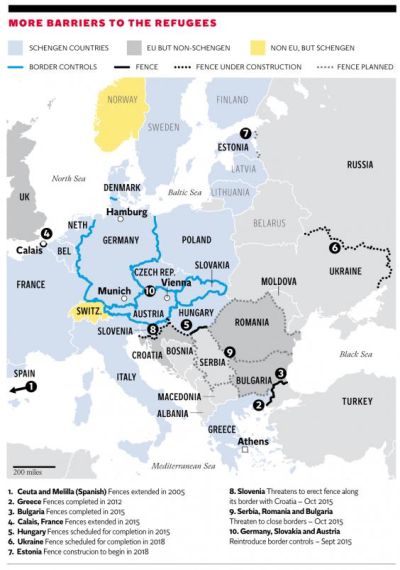
By INcontext Ministries — Originally published in A World In Motion, Issue 157, September 22 2016
Work on building a wall along the approach road to the French port of Calais, to try to stop migrants from jumping aboard trucks bound for Britain, will begin this month British officials said. Immigration Minister Robert Goodwill told lawmakers that security was being stepped up in Calais, home to the “Jungle” camp where thousands of migrants, fleeing war and poverty in the Middle East and Africa, hope to cross the English Channel to Britain. Goodwill said the wall was part of a 17 million pound ($22.75 million) package of security measures agreed by Britain and France in March. (Reuters)
Building walls
Perhaps the most well-known ‘dividing wall’ in recent history was the one separating East and West Germany after the Second World War. What became known as the Berlin Wall began as a razor wire fence that was first constructed in 1961, followed by an actual concrete wall built in 1975. Removal of the wall began in November 1989. The primary purpose of the wall was to stem the flow of refugees leaving East Berlin, which was under Soviet control.
41 years later, walls are again being built, but this time it is not to keep people in – the Calais wall is intended to keep refugees and migrants out (of Britain in particular). And it is not the only one.
During 2014/5, the European Union allowed more than 1.3 million refugees/migrants to enter the region. But with no end in sight to the war in Syria and with conflicts continuing in the wider region, European countries have started limiting their intake of refugees. And with the Turkey-EU deal (for Turkey to limit the number of refugees entering Europe) hanging in the balance, European countries are fearing further waves of refugees that would greatly overwhelm the current reception centres and allocated resources.
In Hungary, Prime Minister Victor Orban announced plans to construct a 280-mile-long razor wire fence to seal off the country from Southern Europe. Austria and Slovenia are also building border fences, while Bulgaria is planning a 100-mile fence along its southern border with Turkey. Greece, having been troubled by illegal migrants from North Africa for years, built a wall in 2012 and now plans to build another along its border with Turkey. Even Norway is building a fence along its arctic border with Russia, where more than 5 500 refugees (mostly Syrian) entered in 2015.
Not all the walls being erected across Europe are for the purpose of preventing the influx of refugees. Ukraine and Estonia are planning to seal their borders with Russia in a bid to limit Russia’s destabilising influence in the region. Ukraine, already struggling to finance its war in the Donbas region, plans to invest $250 million in building a 1200-mile defence along its border with Russia.

From a Christian perspective
Building walls for security reasons is one thing, but building walls for the purpose of keeping out refugees (who have lost everything and face death if they stay) is another.
Some use passages like Matthew 21:33 to support the principle of defensive walls (There was a landowner who planted a vineyard, built a wall around it and built a watchtower…). Pope Francis, however, said the following in response to Donald Trump’s proposed wall between Mexico and the US: “A person who thinks only about building walls, wherever they may be, and not building bridges, is not Christian. This is not the Gospel.”
Europe, together with the US, is often still equated with the ‘Christian West’ (regardless of its gradual secularisation). And for people attempting to flee the conflict in the Middle East, it is widely regarded as a ‘safe haven’, primarily because of the Christian values instilled within its governments and societies.
Walls that are built to better manage the influx of refugees (having them enter through specified points supported by intake teams as opposed to random crossings) may make practical sense, but walls that are built to stop refugees from entering Europe entirely will have widespread negative effects. In many ways, such walls would confirm the negative teachings that many mosques in the Muslim world give about the ‘Christian West’, cementing false worldviews and even playing into the hands of hardliner Islamists.
Many churches in Germany (visited recently by an INcontext team) are shining examples of how the ‘Christian West’ has embraced Muslim refugees, taking them in and sharing the Gospel with them in love and welcome. This has resulted in multiple conversions to Christianity. If walls take root throughout Europe, doing this will no longer be a possibility for European believers. While open borders may be classified as a “risk” by many, they offer the Church an unparalleled opportunity to live out its Biblical mandate among those seeking help and refuge.
Pray
For there to be a greater focus on building ‘bridges’, rather than walls
For Christians to be those who reconcile
For the European Church to fully embrace the opportunities afforded them to reach Muslims with the Gospel







“From a Christian perspactive”? – No, from a left liberal main stream church perspective, even quoting the roman catholic pope.
As much as I agree with you as to the disallowing the refugees on a humanitarian basis, I think that you overlook the problems of disallowing the “refugees” on the basis of the effect of our Judaeo-Christian ethics and norms as has already been shown in France, Holland and Germany.